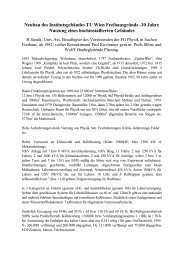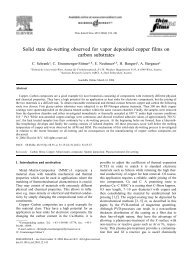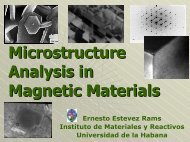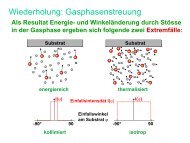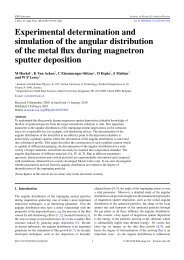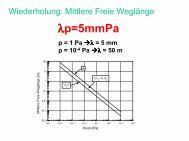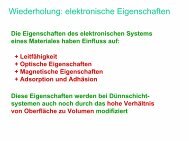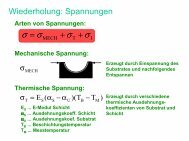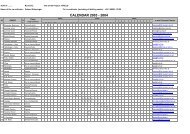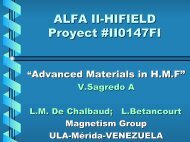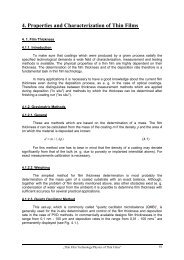Sin tÃtulo de diapositiva
Sin tÃtulo de diapositiva
Sin tÃtulo de diapositiva
You also want an ePaper? Increase the reach of your titles
YUMPU automatically turns print PDFs into web optimized ePapers that Google loves.
Magnetic interactions and<br />
Preisach distributions of<br />
nanostructured barium hexaferrite<br />
P. G. Bercoff, M. I. Oliva and H. R.<br />
Bertorello<br />
Facultad <strong>de</strong> Matemática, Astronomía y Física<br />
Universidad Nacional <strong>de</strong> Córdoba<br />
Argentina
INTEREST<br />
To study the interaction mechanisms in Ba hexaferrite<br />
TOOL<br />
PREISACH MODEL<br />
Preisach Distribution Function:<br />
f(h c , h u )<br />
h c : coercivity of each particle<br />
h u : internal field seen by each particle<br />
IDENTIFICATION: Hc<br />
hc
FIRST ORDER REVERSAL<br />
CURVE (FORC)<br />
2<br />
M( α,<br />
β)<br />
∂<br />
f( α ,<br />
β<br />
) = −<br />
(1)<br />
∂ ∂<br />
α<br />
β<br />
α=<br />
h + h<br />
u<br />
c<br />
β = h h<br />
u<br />
−<br />
c
SAMPLES<br />
Three samples with different microstructure<br />
Sample Preparation Composition / Microstructure<br />
M1<br />
MF1<br />
MF8<br />
HEBM of stechiometric<br />
Fe 2 O 3 and BaCO 3 . 1 hour<br />
at 1000ºC in air in pow<strong>de</strong>r<br />
form, then compacted.<br />
HEBM of Fe 2 O 3 BaCO 3<br />
and 20% α-Fe .<br />
Compacted and 1 hour at<br />
1000ºC in air.<br />
HEBM of Fe 2 O 3 BaCO 3<br />
and 20% α-Fe . 8 hours at<br />
1000ºC in air in pow<strong>de</strong>r<br />
form, then compacted.<br />
Highly crystalline phase M<br />
(BaFe 12 O 19 ).<br />
D ≅ 50 nm<br />
Phase M plus ∼20% hematite.<br />
Partial, short-range sintering.<br />
D ≅ 50 nm<br />
Phase M plus ∼20% hematite.<br />
Larger <strong>de</strong>gree of sintering.<br />
ρ ≅ 0.7 ρ theo<br />
D ≅ 60 nm
RESULTS<br />
We measured the FORCs of the three samples and calculated<br />
the corresponding Preisach distribution functions using Eq. (1)<br />
BM1
BMF1
BMF8
CHECK OF RESULTS<br />
χ<br />
i −calc<br />
i<br />
=<br />
χ<br />
i<br />
tot<br />
− χ<br />
i<br />
rev<br />
=<br />
∂M<br />
i<br />
− χ<br />
∂H<br />
i<br />
rev<br />
=<br />
∞<br />
∫<br />
0<br />
f(h ,h − H<br />
c<br />
c<br />
i<br />
i<br />
)dh − χ<br />
c<br />
rev<br />
BM1
BMF1
BMF8
DISCUSSION<br />
The Gaussian-shaped<br />
shaped Preisach distribution of M1 could be attributed to the<br />
fact that this sample is composed only of phase M and there is no reason to<br />
believe that the fabrication process would produce other kind of particles<br />
distribution on the plane ( (h , h ).<br />
c u<br />
The multiple peaks observed in the Preisach distributions of MF1 and MF8<br />
suggest that they represent different groups of conglomerates that invert their<br />
magnetization at the fields h of the maxima. . It is highly probable that the<br />
sintering process has produced c a distribution of conglomerate sizes, each<br />
conglomerate with a well <strong>de</strong>fined h value. The larger the number of particles per<br />
c<br />
conglomerate, the lower the corresponding h . c
We i<strong>de</strong>ntify the coercive fields of the samples H exp with the maxima h c c of<br />
the Preisach distributions. Then, from the modified Brown equation we can<br />
<strong>de</strong>fine an effective anisotropy constant, given by:<br />
K<br />
eff<br />
1<br />
= K<br />
1<br />
α<br />
K<br />
α<br />
ex<br />
=<br />
H<br />
exp<br />
c<br />
M<br />
S<br />
2<br />
+ N<br />
α φ<br />
eff<br />
M<br />
2<br />
S<br />
As the exchange length in this systems ( (l =8 nm) is lesser than D, we <strong>de</strong>duce<br />
that there is a partial coupling between the ex particles of phase M insi<strong>de</strong> each<br />
conglomerate and there are regions of lower coercivity produced by the exchange<br />
coupling. If we accept that there is a distribution of conglomerates with<br />
different number of particles that invert their magnetization at different<br />
coercive fields, we can infer that the exchange interaction in these t<br />
systems<br />
<strong>de</strong>pends on the number of particles per conglomerate.



